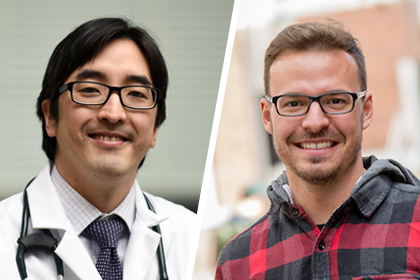Can schools safely remain open or reopen during periods of significant community spread of COVID-19? According to predictions from a UVM model of SARS-CoV-2 transmission in the school setting, yes – if appropriate precautions are followed both in school and in the community.

Benjamin Lee, M.D. (left), and Laurent Hébert-Dufresne, Ph.D. (right).
Shanghai-based mathematical model predicts when schools can be open/reopen
Can schools safely remain open or reopen during periods of significant community spread of COVID-19? According to predictions from a model of SARS-CoV-2 transmission in the school setting, yes – if appropriate precautions are followed both in school and in the community.
The study results are published in BMC Public Health.
School closures during the COVID-19 pandemic have been based predominantly on models of pandemic influenza transmission. However, say the study’s authors, recent evidence suggests that “children under the age of 10, are less susceptible to SARS-CoV-2 infection and rarely transmit the infection to adults or schoolmates.”
For their study, University of Vermont researchers adapted a previously-published model using contact data from Shanghai, China to investigate the impact of open schools on community spread of SARS-CoV-2 infection.
A critical feature of the model is the measurement of contact structure across all age groups, with a focus on the rate of daily contacts in the community and social contacts in school – and how a reduction in contact frequency affects transmission risk.
The team combined contact patterns observed between different age groups during pre- and post-pandemic “lockdown” periods to simulate various levels of school reopening and also tested these effects across a range of estimates of lower susceptibility rates to infection in younger children.
According to first author Benjamin Lee, M.D., associate professor of pediatrics and a pediatric infectious diseases specialist, the model helped identify conditions that would support keeping schools open. Ideally, he said, the average number of daily social contacts in the community needs to be reduced to about 40 percent of pre-pandemic baseline, and total contacts for children aged 10 to 19 needs to be reduced to 33 percent of pre-pandemic baseline. If this can be achieved, having open schools would be feasible even starting from a point of significant community transmission.
“In other words, necessary restrictions in the community with careful mitigation for older kids is the trade-off that will enable schools to remain open,” said Lee. “Schools should be the last to close and first to re-open.”
The study demonstrates how considering a combination of different measures is beneficial in creating a path to having schools be open to the extent possible, within a broader set of restrictions.
“It's not just about the scale of restrictions, but also about how targeted these restrictions are, because the structure of contacts matters,” said senior author Laurent Hébert-Dufresne, Ph.D., assistant professor of computer science.
“This study provides a basic proof-of-principle that we believe can be applicable to many settings that have similar contact structures,” said Lee.